By far the most common surgery used in periodontal therapy is flap surgery. Moderate to advanced periodontal disease involved gum pockets (See What Is Periodontal Disease? ) that are too deep to clean without reflecting back the gum tissue for access. Without this access, deep calculus and plaque cannot be removed from the root, and the disease will progress. This surgical cleaning procedure is often called open flap curettage.
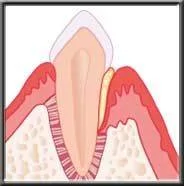
Deep pocket with calculus
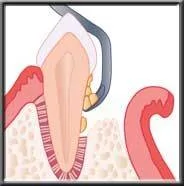
Flap reflected to access calculus
Once the pocket is cleaned, the gum may be returned to its original level. This results in a clean root, but the deepened space is still present. Frequent cleanings by the hygienist are necessary to remove the plaque in the residual pocket that the patient cannot reach with flossing and brushing (See Periodontal Maintenance ). Even when there is good oral hygiene and regular quarterly recalls, the bacteria may still continue to cause the pocket to become reinfected. When cosmetics are not a concern (on the lower teeth, the inside of the upper teeth, and the outside of the upper back teeth), the surgeon may elect to suture the gum down to where the bone has resorbed, reducing the depth of the space. If the space is reduced to 3 millimeters or less, the patient is able to reach the bottom of the space with daily brushing and flossing, eliminating the disease.

Gum sutured back to normal height, leaving a deepened space

Gum sutured down to bone to reduce residual space.
In the majority of advanced cases, the bacteria has caused the bone to resorb and become pitted. In these cases flap surgery gives access not only for root cleansing, but allows for recontouring of the bone itself. By performing this osseous surgery, and reshaping the bone to its natural scalloped shape, it is generally possible to eliminate moderate pockets.
The patient is then able to prevent recurrence of the disease by keeping the shallow space clean with brushing and flossing.

Bone recontoured after
flap reflected.

Tissue sutured down to smooth
bone to eliminate pocket.
Flap surgery is also needed if regeneration procedures are to be performed. Here the gum is reflected back to allow insertion of bone or guided tissue regeneration membranes (See Regeneration Surgery).
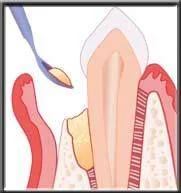
Flap reflected to allow
bone implant

Flap resutured over
bone implant
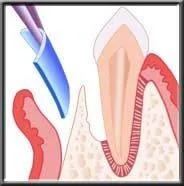
Flap reflected to
insert membrane
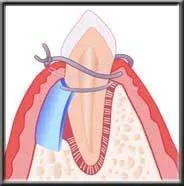
Flap resutured
over membrane
In summary, for most moderate and advanced cases, it is important to be able to reach far under the gum to treat the infection and diseased tissues. By using flap surgery, the periodontist is able to access these areas to provide the optimal care available. With today's medications, surgery should be painless with only a minimal amount of post-operative discomfort (See What to Expect from Surgery ).